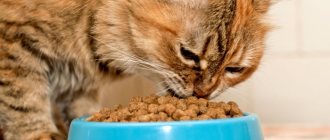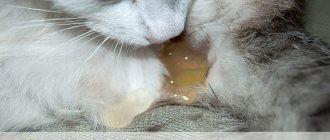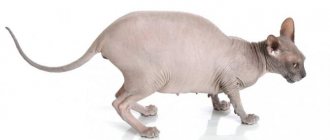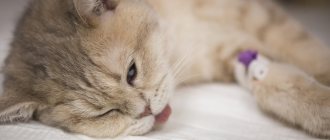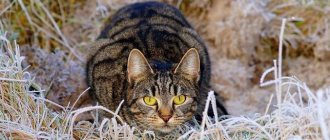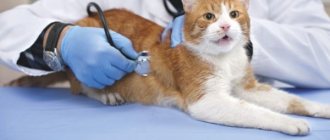During pregnancy, special care for the cat is important, as well as careful monitoring of its condition. The first sign of pathology is bloody discharge, which can accompany the development of diseases in the cat itself and in kittens. In addition, there are several blood release factors associated with physiological processes. In any case, the symptom cannot be ignored.
What is considered normal?
Even a nulliparous cat produces clear mucus during estrus, which is normal and does not pose a threat to health. After mating, pink discharge may appear. These are unfertilized eggs that are released from the uterus. Moreover, the inclusions that occur during this period can be red or brown, outwardly similar to elongated veins. This process is also considered normal and indicates that in the uterus of a pregnant cat the flora is sterile and inflammation is completely absent.
Until the end of the 3rd week, clear or transparent white discharge may appear. These are the remains of the mucus plug coming out of the uterine loop. Until the 6th week there should be no discharge, but sometimes you can notice how a white liquid without odor or other inclusions comes out from under the tail. This is excess amniotic fluid, and the situation itself does not pose a threat to the health of the pet. In late stages and at the beginning of labor, you can expect mucous discharge, indicating that one fetus has already begun to move through the birth canal.
When a cat’s bleeding during pregnancy is abundant and has an unpleasant odor, this directly indicates pathological processes that, if left unattended, are dangerous for the life of the pet and the offspring.
Types of discharge and reasons for their appearance
If an animal has damage to the tissue of the uterus itself, then it develops hematuria.
- Bright red. Such discharge in a pregnant cat is always a bad sign. If after 10 min. liquid has not stopped coming out from under the tail, and the total volume exceeds 1-2 tbsp. i.e., this is full-fledged bleeding. During pregnancy, a common cause of bleeding is damage to the uterine tissue. In such situations, there is often blood in the urine.
- Brown. If, 8-9 weeks after conception, a cat has bloody, brown fluid flowing from the genitals, placental abruption may have occurred. In such a situation, the veterinarian will advise monitoring the cat; the last resort is a cesarean section or induction of labor.
- Greenish. Cloudy, white-green discharge with a foul odor is an almost guaranteed sign that one or more fetuses have died in the cat's womb. The situation threatens severe intoxication and gradual impairment of kidney function.
- With pus. Purulent discharge of fawn, green or yellow color indicates the progression of an inflammatory complication. In such situations, the veterinarian most often induces artificial labor in the cat, otherwise the pus may spread to the internal organs, causing sepsis.
Why is it dangerous?
The development of pathogenic bacterial flora is one of the serious complications of a pet’s condition.
Bloody, green, yellow discharge during pregnancy is always a pathological sign indicating some kind of disorder within the body of a pregnant cat. If this condition is not treated, the discharge will not stop flowing on its own. Depending on the causes of the pathology, the risk of the following complications increases:
- complete placental abruption and premature birth;
- intrauterine death of kittens and termination of pregnancy;
- necrosis of tissue of the uterus and other organs;
- the addition of a bacterial infection and its spread;
- impaired renal function;
- death of a cat from complications.
Pink discharge that is not dangerous
Discharge in the first period of a pale pink color is most often associated with the release of unfertilized eggs to the outside.
If such bleeding does not intensify and does not have a foreign odor, then there is no need to worry.
In the second period, there should normally be no bleeding. During this period, babies are actively gaining growth, the uterus is expanding, and the animal’s tummy is noticeably rounded. If there is noticeable scarlet bleeding that lasts more than 10 minutes, you should immediately consult a doctor. Possible causes: uterine rupture, inflammation, miscarriage.
In the third period at the end of pregnancy, a small bloody discharge (blood volume maximum 1 tablespoon) can serve as a harbinger of the onset of labor.
Dirty yellow discharge during childbirth is usually not serious and is associated with the waste products of kittens in the womb.
Cats are very clean by nature, so if your pet feels good, is cheerful and cheerful, then she licks herself on her own and the owner does not have time to notice anything. The presence of sticky lumps of mucus around the animal's loop should alert you. This is a sign that the pet is unwell and needs urgent help from the owner.
Normally, the owner should not notice any discharge
Diagnostic measures
If suspicious discharge appears in a cat before or before birth, it is necessary to take the pet to the veterinary clinic as soon as possible, where it will be examined by a veterinarian. The doctor will determine the nature of the discharge, whether it is pus, blood, ichor or transparent white mucus. Pink discharge without other inclusions in the early stages of pregnancy is considered normal; if the cat feels well and is not worried, then there is nothing to worry about. It’s another matter when there is bleeding from the genitals, with blood flowing or dripping constantly, the animal feels bad, is worried, or, conversely, is lethargic and passive. Then a referral is given to the following diagnostic methods:
- general blood and urine analysis;
- microbiological examination of secretions;
- Ultrasound.
Normal discharge that you shouldn't be afraid of
You should not pay special attention to pinkish discharge from a pregnant woman after mating. If they correspond to the periodization of estrus, this cannot be considered a serious symptom. It is, of course, worth assessing the abundance of these secretions.
It is also necessary to take into account the fact that until the uterus is completely closed, there may be extra eggs in the discharge. These are stringy brown lumps that can resemble small leeches. This is a completely normal process, which indicates the sterility of the flora in the pregnant woman’s uterus, which allows the embryos to undergo the process of mummification. Such cases indicate the absence of inflammation.
How to treat?
The owner needs to be close to the pet at such an important moment and monitor so that no complications occur.
Clear, light pink bleeding before childbirth is considered normal, so treatment is not required. The owner needs to monitor the pet’s condition, calm her down during childbirth, and do everything to ensure that the process ends safely. At the same time, during childbirth, it is important to pay attention to the nature of the amniotic fluid, color, and smell. If you have any suspicions, it is better to tell everything to the veterinarian, who will refer you for additional examination and, if necessary, prescribe restorative treatment.
In case of uterine abruption, when bloody discharge comes from under the tail, the doctor first of all takes into account the timing of pregnancy. In the later stages, constant monitoring is carried out, and comprehensive analyzes are carried out. Delivery usually occurs without complications unless the animal has other health problems. If abruption occurs in the first half of pregnancy, and the bleeding is profuse, there is no other choice but to artificially induce labor, since the cat may die.
No less dangerous than bloody discharge are purulent discharges, which are often the result of the death and decomposition of one or more fetuses. In such situations, the veterinarian prescribes effective antibiotics and other drugs to avoid complications. If the condition does not return to normal, the doctor will suggest a cesarean section or termination of the pregnancy to save the animal’s life. After surgical treatment or urgent induction of labor, long-term rehabilitation under the supervision of a physician will be required.
Pregnancy periods by week and dangerous periods
A cat's pregnancy lasts 9 weeks. It occurs in several stages:
- early – up to 3 weeks;
- fetal formation – up to 6 weeks;
- prenatal – up to 9 weeks.
Cat waiting for offspring
Different secretions occur in each period. Kitties themselves are very clean and sometimes it’s hard to see her discharge. At the first stage of gestation, a light pink secretion may be released. During this period, the egg only attaches to the uterus. In the second stage of development, the transparent mucous part of the plug may separate as the cervix closes.
Important! If the discharge is bloody, then you should pay attention to this. They should not be confused with normal ones. There is a possible risk of miscarriage. A veterinarian's consultation is required.
At a later date, a secret may appear again, because the baby is due soon. Possible mucous scarlet secretion.
Bloody and green discharge with a specific odor in a cat during pregnancy always indicates a pathological process, which is why additional symptoms appear. The reasons may be different: inflammation of the reproductive system, placental abruption, fetal death, etc. In some cases, this indicates diseases that require urgent treatment.
Vaginitis
Inflammation of the vagina. A diagnostic sign is that the cat begins to lick itself quite often, hiding the discharge. This makes diagnosing the disease difficult. A mild form can be cured with douching, a severe form can be treated with antibiotics.
Endometritis
Inflammation of the uterus. It is caused by intrauterine infection, as a result of which the animal can give birth to weakened or premature babies, who sometimes even die. Acute endometritis, if left untreated, leads to the death of the cat. And as a result of chronic endometritis, hydrometra can develop. The secreted secretion itself can be of different shades, any consistency and smell.
Hydrometer
Accumulation of fluid, exudate, and secretions of the uterine glands in the uterine cavity. As a result, the uterus swells. Scanty or spotting discharge is possible. It often develops against the background of chronic endometritis. Emergency treatment is necessary, otherwise the cat may die.
Hematometer
Occurs in case of uterine injury or inflammation. Blood accumulation occurs. During pregnancy, a cat will have bloody discharge from the uterine cavity.
Pyometra
An inflammatory disease of the uterus, as a result of which pus accumulates in it. Due to hormonal imbalance or pathogenic flora entering the cavity, endometritis begins to develop.
Schematic drawing of pyometra in a cat
Pyometra occurs in two forms:
- open. The resulting pus leaves the uterine cavity to the outside. The owner can easily detect such departments and begin urgent treatment;
- closed. With this form, pus accumulates inside, thereby inflating the uterus. Diagnosing the disease in this case is much more difficult. It is necessary to observe the behavior of a pregnant cat. Lethargic and apathetic state, fever, loss of appetite, profuse thirst, the cat often begins to lick itself, often urinates, while breathing is heavy.
First (from 0 to 3 weeks). During this period, fertilization occurs and the embryo attaches to the wall of the uterus.
Second (from 4 to 6 weeks). The uterus increases several times. The kittens grow up and their movements become noticeable.
Third (from 7 to 9 weeks). The babies take on their final appearance, and the pet is preparing for childbirth.
The most dangerous are the first period, where the cat is highly likely to lose the fetus, and the third period, where the onset of premature birth or complications that will negatively affect further pregnancy is possible.
At any time, the appearance of brown blood discharge should alert you. Dark blood color indicates placental abruption or even fetal death. The correct diagnosis and subsequent treatment can only be prescribed by a veterinarian after passing all examinations.
If, in addition to blood, a sharp disgusting odor is observed from the pet’s loop, then this may be a sign of severe inflammation or decomposition of the dead fetus.
This situation is very dangerous for the cat, because its body suffers from noticeable intoxication. Help in this case must be provided very quickly, otherwise the woman in labor may die.
On average, a cat's pregnancy lasts about 9 weeks. They are often divided into 3 main stages. This:
- up to 3 weeks – early stage;
- up to 6 weeks – period of fetal development;
- up to 9 weeks - prenatal stage.
The most difficult are the first and last periods. At the equator of term, a pregnant cat mainly satisfies its physiological needs, conserving energy. At this moment, the kittens are just growing, starting to move and show signs of life. Of course, during this period, discharge from a pregnant cat cannot be considered normal. But they may be allowed in a number of situations.
The problem is that cats are too clean. They lick themselves so thoroughly that the owner may not even notice that something is wrong.
But the first stage of a cat’s pregnancy is often associated with light pink discharge. It is at this time that the eggs immerse themselves in the uterus and become attached to it. Therefore, small discharge during pregnancy is acceptable. Already at 4 weeks the uterus closes. This can cause mucous formations in the pregnant woman that will be clear and watery. They are not so easy to detect, because they come out when urinating.
A slight watery mass of clear or yellowish color may appear, but there should be no other discharge. At this moment, the uterus fills with water, which squeezes excess fluid out. Therefore, with small clots that do not cause discomfort to the animal, there is no need to panic and once again disturb the pregnant woman. However, in other cases you should immediately seek the help of a doctor.
Towards the end of the term, the pet begins its prenatal preparations. This is when a pregnant cat may have discharge before giving birth. Acceptable period is up to 1 day. If the owner notices that the mucous membrane begins to be rejected, this becomes the most reliable signal that labor has already begun.
After the pregnant woman has passed the stage of active contractions, you can notice an almost transparent yellow liquid. Sometimes it gives way to more bloody clots. It is worth understanding that maintaining cleanliness is inherent in the cat’s instincts. Therefore, if a cat begins to have discharge, the animal refuses to be washed, and the owner notices an accumulation of mucus in the pregnant woman’s loop and matted fur, the pet should be immediately shown to the veterinarian. There are several reasons for this unusual behavior. Among them:
- fatigue;
- intoxication;
- painful sensations.
Therefore, you should not rely on chance and make a pregnant woman suffer. A veterinarian will quickly determine the cause of the problem and help ease the difficult period.
Everyone understands that the main threat can be bleeding from a pregnant cat. This is always a bad indicator. Particular attention should be paid to light red clots that take more than 10 minutes to come out and exceed 2 tablespoons in volume. Here we can talk about real bleeding, which should be stopped immediately, otherwise the pregnant woman may have complications, including death. Often the cause of such processes is uterine rupture.
In addition to the fact that bloody discharge poses a threat, if the owner notices brown discharge in a pregnant woman in the middle stage, this may indicate that the placenta has separated. It can also be a symptom of the death of offspring. If the detachment occurs at a later stage (in the last week of pregnancy), do not panic.
- enhanced therapy;
- causing premature birth;
- surgical intervention.
We suggest you read: The cat hiccups what to do - causes of hiccups in cats
Having seen green discharge from a pregnant woman with a pronounced odor, we can draw conclusions about the death of one or more kittens. This symptom indicates the beginning of the decomposition process. In addition, this may indicate that the pet’s internal organs are affected by intoxication, and her kidneys are beginning to fail. This can only be dealt with by urgent induction of labor or cesarean section. After this, the cat will need serious recovery and therapy.
Depending on how far along the pregnancy is and what results the tests give, a decision is made to support the cat’s body or terminate the pregnancy. In this case, you should always rely on the advice of a doctor, who will determine the degree of danger of further childbirth for the pet.
The body of a pregnant cat is extremely sensitive and unpredictable. Therefore, the owner has a great responsibility. Only he can monitor the development of dangerous symptoms that can cost the life of the cat herself and her offspring. The main thing is to pay attention to your pet and, in case of complications, promptly conduct an examination at a veterinary clinic.
A pregnant cat is the most affectionate and gentle creature in the world. She showers everyone around her with care, warmth and, however, requires no less attention. During such periods, especially if the upcoming birth will be the first, it is important to establish a kind of emotional contact with the animal. This most often manifests itself in mutual stroking: the cat rubs against the legs and arms of the owner, and they, in turn, gently scratch behind the ear and lightly rub over the tummy.
Often a pregnant cat has discharge from the loop for several days or months, as well as urine with blood flowing, toxicosis and strange behavior are observed. It also happens that the belly has decreased, sagged, is very large, or there is no belly at all. In each case, a consultation with a veterinarian and an ultrasound will not be superfluous.
The article discusses different situations that help to understand how pregnancy proceeds in a Scottish Fold cat, Russian Blue, Oriental, Siamese, Thai and other breeds of cats. Of course, there may be rare exceptions, but in general the information for all pores will be identical.
Preventive methods
It is important to show the animal to the doctor in time so that it can carry to term and give birth to offspring normally.
When the owner finds out that his pet is pregnant, he is very happy and tries to do everything for the cat so that this period passes safely and healthy kittens are born. However, sometimes a cat's pregnancy does not go smoothly. In such a situation, it is important to react in time and contact a veterinarian, who, based on the diagnostic results, will advise what to do next.
As a preventative measure, it is recommended to always monitor your cat’s health, vaccinate on time, carry out deworming, and treat viral and infectious diseases. In addition, periodic preventive examination of the animal will not hurt. When pregnancy occurs, it is important to carefully monitor the condition of the pet, monitor its behavior, quality of nutrition, and physical activity. You definitely need to listen to the veterinarian’s advice, try to properly care for your cat, and protect it from stress. If the maintenance and care are correct, the cat usually safely carries the kittens to term, and the birth takes place without complications.
When any discharge appears, you should call a veterinarian
At the very beginning of pregnancy, immediately after mating, light pink discharge is possible. This is due to the formation of a mucus plug, part of which comes out. This is a homogeneous transparent mucus without a specific odor. This is a normal situation, there is no need to panic.
Necessarily! There are discharges, if detected, you should immediately contact a specialist.
Bloody, yellow, green, with brown clots, discharge with a specific odor - these are the symptoms that you need to pay attention to. May be accompanied by fever, restless behavior, lack of appetite, frequent drinking and urination, and cramping pain.
Important! Do not confuse blood in a cat before birth with pathological discharge.
Three days before delivery, the mucus plug comes off.
There may be stool coming out of the anus. There are completely different reasons and a different treatment.
Prevention
In order for the process of bearing offspring in your animal to go smoothly, it is important to carry out preventive measures in a timely manner. Moreover, it is better to carry out some of them not at the moment when mating occurs, but throughout the entire life of the animal.
Monitor the animal’s health, get all the necessary vaccinations on time and select the right food, taking into account all the parameters. It would also be a good idea to have periodic checkups with a veterinarian.
After mating, you should carefully monitor the condition of the animal and pay attention to even the smallest changes.
- All the veterinarian's instructions must be followed very carefully.
- During pregnancy, you should protect your pet from cold, drafts and dampness.
- For mating, you should choose a healthy partner who has all the necessary vaccinations.
It is important that mucous discharge can also appear in a sterilized cat a short time after surgery. They have a slimy consistency and yellow color, but do not have a strong odor. If such discharge does not stop for a long time, then you should show your pet to a veterinarian, as inflammatory processes are likely to develop.
Proper care and following all doctor’s recommendations will help your cat have a normal pregnancy and give birth to healthy kittens. It is important for the owner only to pay attention to the condition of the pet, and everything else will happen by itself.
This article has been checked and approved by a veterinarian. Knyazeva Anna Vladimirovna, veterinarian in private practice, Moscow. more about the expert.
(you can vote for the article)
Tags: cat pregnancy, cat discharge, cat
- Related Posts
- Umbilical cord in kittens: how to help a cat separate it?
- Sphynx Bambino: an unusual breed of cat!
- Yorkie dog breed. Types of Yorkies
Cat behavior
Cats themselves are clean animals. Any discharge during pregnancy (including blood) may remain unnoticeable to the owner, since the pet will lick everything. In this case, remaining blood in the tail area and constant licking of this area may be a warning sign. Some owners perceive frequent licking of the loop as an indicator of the pet's cleanliness, but in reality, in this way the animal is trying to reduce the pain of the inflamed area. In addition, you should pay attention to other alarming symptoms:
- lack of appetite;
- lethargy and apathy;
- depressed state.
Diagnostics
To accurately determine the cause of discharge in a pregnant cat, you need to conduct a number of studies:
- general blood analysis;
- blood chemistry;
- general urine analysis;
- bacteriological urine culture;
- abdominal x-ray;
- Ultrasound examination.
Ultrasound diagnostics of the expectant mother
Precautionary measures
Simple precautions will help to significantly reduce the risk of bleeding in a cat during pregnancy and carry her healthy offspring. For this it is important:
- Prepare the body for conception with a balanced diet and vitamin supplements to support immunity (after consultation with a veterinarian).
- Get your required vaccinations on time.
- Avoid active and active games during pregnancy, during which injury to the abdominal area is possible.
- Ensure a comfortable room temperature and absence of drafts.
- Give your cat enough attention to notice changes in behavior and health in time.
Veterinarian advice for bleeding in a pregnant cat: video

